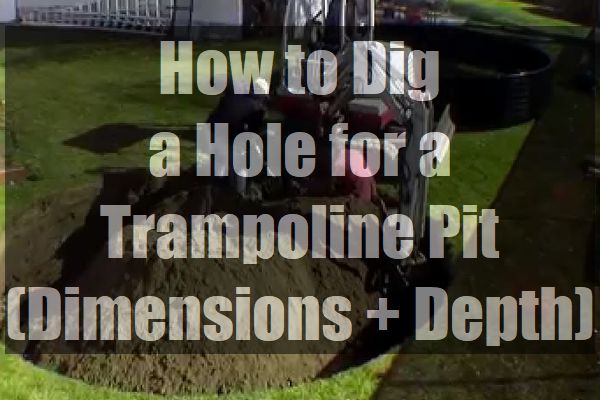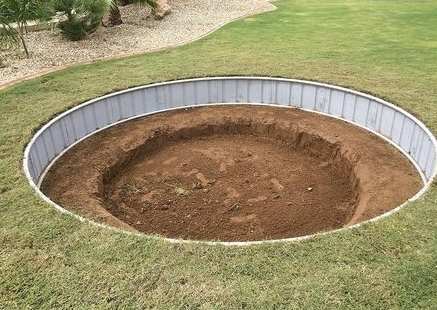
How to Dig a Hole for a Trampoline Pit (Dimensions + Depth)
So you want to install an in ground trampoline in your back yard. You have weighed the costs, you have considered the problems that you will face digging your trampoline pit and you still think it is a good idea.
The benefits to having an in ground trampoline do outweigh any negatives that come from owning one. You will get great exercise, improve your health and have a lot of fun. These benefits help you overcome the difficulties that arise as you set out to install your new in ground trampoline.
Tip #1: if you are not sure what is involved in installing an in ground trampoline then call a licensed contractor who has experience in this work. They should be able to help you through the tough parts and give you a free estimate
Introducing The BERG Inground Trampoline
- Large 14 ft jumping surface for big jumps
- UV Resistant PVC padding that will last for years
- Less air resistance for higher jumps
Before You Start Digging Your Pit
There are three things you must do before you put your shovel into the ground.
Phone your local city hall - you will need to get information about your back yard before you do anything else. You need to know where to dig, if it is safe to dig, where any pipes are, including your own sewer and water lines. You also may need to know if you need to get a permit to install an in ground trampoline.
Know the size of your trampoline - it is obvious that you cannot start digging if you haven’t decided how big the trampoline is going to be. You need to make this decision first, before you start your personal excavation. The once you know the diameter size, you need to an an extra foot to make allowances for the ventilation you will need.
Know the size of your yard and what is in it - one of the keys to installing an in ground trampoline is knowing if your yard is big enough to put an in ground trampoline in it. Then you need to check how your yard looks to see where it can safely go. You may have to uproot trees, plants, move a shed or a garden and so on,
Tip #2: never assume the space underneath your yard is free from pipes, or other items that may be expensive to repair. It is always better to be safe rather than sorry
Round Trampolines Outer and Inner Hole Diameter
You may have thought that you are digging only 1 hole but that is not the case. There are actually two holes that need to be dug in order to install your in ground trampoline properly.
The outer hole is not going to be as deep as the inner hole. In fact, you only have to dig down 13 inches to get the right depth for the outer hole. This is basically the same measurement for an 8, 10, 12 & 14 foot diameter trampoline.
The inner diameter hole is not so lucky. Each measurement for the inner diameter is different for each size of trampoline. The rule of thumb is to dig the inner hole 2 feet less in diameter than the trampoline’s actual diameter size.
For example,. an 8’ diameter trampoline needs a 6’ diameter inner hole. A 10’ diameter trampoline needs an 8’ inner hole. The 12’ needs a 10’ inner hole and the 14’ needs a 12’ inner hole.
The difference creates a nice ledge which you can put your retaining wall on. Of course, the outer and inner diameter size may not be absolute and some trampolines may require variances from the figures above.
Also keep in mind that it is very difficult to dig a perfect circular hole. If yours is a little uneven in diameter that should still be okay. Just don’t make it to far off the mark. Just keep to the 1 foot extra rule and you should be okay
Then do not start to dig the inner hole until you have finished the outer one.
Tip #3: never make the hole the same size as your trampoline diameter. You will have trouble getting in the hole, a hard time getting it out and you will also have ventilation problems
Rectangular Trampolines Outer and Inner Hole Diameter
If you think digging a circular hole was fun, then wait till you see the work involved in digging a rectangular hole. Here are the measurements for the different sizes of trampolines. The 8 foot is not included here and add 20 cms to the inner hole’s figures to get the outer hole size:
10 by 6 foot trampoline - the inner hole should be 8 by 4 foot
11 by 8 foot trampoline - the inner hole should be 9 by 6 feet
14 by 10 foot trampoline - the inner hole should measure 12 by 8 feet
Again these sizes may vary depending on the the brand of trampoline you buy.
How Deep the Hole for a Trampoline Pit
This is of great concern as you need to make sure you have the right depth for a number of reasons. The main reason you need to get the right depth is so that you have room to land and bounce backup. Hitting the ground is not a pleasant feeling.
#1. The circular trampoline’s inner hole depth
8 foot trampoline- 29 inches deep
10 foot trampoline- 29 inches deep
12 foot trampoline - 36 inches deep
14 foot trampoline - 36 inches deep

The outer diameter hole’s depth is standard for all 4 trampoline sizes. That hole should measure 35 cms deep. You should also have about a 30 cm. ledge going around the hole.
Tip #4: it is never a good idea to dig a hole more shallow than the recommended measurements. You can go deeper if you like to be sure but never shorter. Going more shallow hurts your bounce and may hurt you
#2. The rectangular trampoline’s inner hole depth
10 by 6 foot trampoline - 30 inches deep
11 by 8 foot trampoline- 30 inches Deep
14 by 10 foot trampoline- 36 inches deep
Digging a Trampoline Pit
If you are going to do it yourself, a few tips on how to dig the right sized hole with the right dimensions are always helpful. It is not a matter of just grabbing a shovel and starting digging away.

It takes a little care to get the hole just right. Here are some guidelines for both the circular and rectangular holes:
- Mark out your hole and make sure to give yourself that 1 foot extra diameter
- Dig the outer hole first going down about 14 inches
- Mark out your inner hole remembering that it is 2 feet smaller than the actual trampoline size. You may have to come in 3 feet to get the right hole size
- Dig the inner hole in a bowl shape. This makes sure you have room for the bottom of the bounce.
- You also should have about a 12 inches ledge. The trampoline’s legs sits on this ledge
- Add in your drainage if needed
There is not a lot of equipment needed to do this job. Here is a brief list:
- String and stakes
- Tape measure
- Hammer
- Shovel(s)
- Carpenter’s level
- Rake
Depending on the size of hole you are digging and if you really do not want to shovel a lot of dirt, you can rent a mini digger to make the digging go a lot faster. The time it should take you to manually dig the hole is about 8 to 10 hours.
Renting a digger can cut that time down to about 2 to 3 hours.
Tip#5: A steel retaining wall is better. It is stronger than concrete and thinner. This would give you more room for ventilation
How to Shape the Hole
Some people may not shape their trampoline holes but that is not a good idea. A rough hole can wreck havoc with your retaining wall measurements and layout. It can also influence your drainage and may keep loose dirt where it can fall and clog up your drainage system
With a circular hole, it will be difficult to use a long , straight 2 by 4 to help you smooth off the sides and ledge. A square head shovel or a trowel can do the trick very quickly. You want to make sure you get as close to circular as you can.
A small 1 by 2, 2 by 2 or 2 by 4 can also help you get the hole shaped to where it needs to be. This work may take you 1 to 3 hours depending on the size of your hole.
Tip #6: Don’t remove your original outlines for the outer or inner holes. Leave them in place so you can shape the holes faster and get them as close to round as possible. The same goes for a rectangular hole. Keep them in place till you got the rectangular hole looking like it should.
Digging Options Pros and Cons (Hand vs Mini-Digger)
In most cases, using a mini-digger is always going to be better, easier and faster. It will save you a lot of time and energy which makes installing your in ground trampoline a lot better.
But mini-diggers are not always the best tool to use when you get beyond the rough work and need to do the finer touches like shaping a hole. Here are the pros and cons for both styles of digging:
#1. The mini-digger
Pros:
Saves you time- power is always going to be faster than manual digging
It saves you energy- you are not doing the heavy lifting
Takes out more dirt- you get bigger shovel fulls out of your hole
Good maneuverability- you can get the right angles when you need them
A better view- you are elevated and can see what you are doing
Cons:
May not fit through your gate- gates can be smaller than mini-diggers
May be too big for your yard- your yard just may be too small to use a mini -digger
Uses fuel- you will not be environmentally friendly and use up fossil fumes while polluting the air. It is expensive to rent and run
Very noisy- you could disturb your neighbors
Easy to make a mistake- you can move a control rod too far or not enough and mess up your hole that delays your installation time
#2. Using a shovel
Pros:
You stay in control- the only thing that works against you is your getting tired
You can be more accurate- you can dig the hole to almost the exact size your outline shows. Your shaping time can be reduced
You build muscles- you get lots of exercise and be healthier
You are environmentally friendly- manual digging does not pollute the environment
You do not disturb your neighbors- you keep the peace and make sure your neighbors can enjoy the day as well
Cons:
Digging takes longer- you could be digging all day
It is not fun- digging can get boring, tiring and you lose your momentum
You can get hurt- your back may go out or you throw the dirt wrong and hurt your knees, hips or back
You can break your shovel- you may hit a rock or steel pipe and ruin your shovel
Tip #7: if your installation is going to take several days, then make sure you have a large tarp to cover the hole on hand. If it rains, you will need to cover your hole. This protects the shape of your hole and keeps you from working in mud.
Tip#8: don’t forget to dig a little path around your tarp and hole to help direct water away from both. A couple of inches should do the trick
Some Final Comments
Digging your hole does sound as bad as it really is. But there is no way to avoid digging if you want an in ground trampoline. The dirt certainly won’t move itself. To make digging easier on yourself just follow the simple steps above and make sure you do not ruin your outline.
You can rent a mini-digger to make the digging part a lot easier and faster but these can be expensive. Not only in rental costs but fuel and oil costs as well. You also need to know what you are doing when you use a digger because one mistake could cause expensive repairs.
It will take a little time to get the hole right for the trampoline you want to install. Just be patient and don’t rush it. When you go too fast that is when the mistakes start happening.
Before you know it, your hole is done and you can install your trampoline and have a lot of fun.
Introducing The BERG Inground Trampoline
- Large 14 ft jumping surface for big jumps
- UV Resistant PVC padding that will last for years
- Less air resistance for higher jumps


